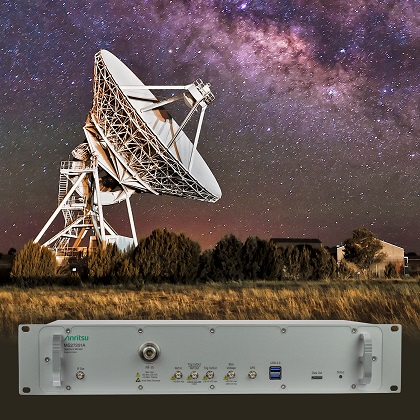
Anritsu Introduces Rack Mount Remote Spectrum Monitors with Frequencies Up To 43.5 GHz
Anritsu Company introduces the�MS27201A�Remote Spectrum Monitor series that includes the industry�s first remote spectrum monitor that covers 43.5 GHz to support new satellite downlink bands. Combining high RF performance with supporting PC software, the�MS27201A�series delivers a unique package for long-term monitoring in a variety of commercial and regulatory environments.
The�MS27201A�series includes 9 GHz and 20 GHz remote spectrum monitors, in addition to the 43.5 GHz model. A wide 110 MHz measurement bandwidth to support common satellite downlink spans complements the 43.5 GHz model. With a displayed average noise level (DANL) of -164 dBm and a third-order intercept point (TOI) of typically +20 dBm, all the remote spectrum monitors assure accurate signal detection and measurement integrity.
A standard PC GUI with the familiar Anritsu spectrum analyzer interface allows users to control multiple instruments and view current spectrum from a single location. As an alternative, Anritsu can have the remote spectrum monitors interface with the MX280001A Vision software. Common trace capture and data storage applications are included in Vision software, eliminating the need for users to develop custom software.
Anritsu also supplies an IQ capture feature that allows users to conduct detailed off-line post-processing on signals of interest. Optional LTE and 5G demodulation software further expand monitoring capability, as does VSA software that allows modulation quality measurements to be made on narrowband signals in accordance with industry standards.
The�MS27201A�series ensure reliable, 24/7 continuous spectrum monitoring over a wide geographic area. A built-in watchdog timer resets the instrument in the event of a software interruption. Should a power disruption occur, the instrument will resume immediate operation with no user intervention required.
The�MS27201A�spectrum monitors are standard 19-inch rack wide and 2U tall, so they can slot directly into test system racks using minimal space. The instruments are powered from a supplied 15-Watt power block that minimizes rack temperature gain.
 Phase Control with Galvanic Isolation
Phase Control with Galvanic Isolation  Tektronix unveils SignalVu Spectrum Analyzer Software Version 5.4 for analysis of up to eight simultaneous signals
Tektronix unveils SignalVu Spectrum Analyzer Software Version 5.4 for analysis of up to eight simultaneous signals  W�rth Elektronik expands its range of power inductors
W�rth Elektronik expands its range of power inductors  Discover the future of 24/7 EMF monitoring with Narda SMARTS AMC!
Discover the future of 24/7 EMF monitoring with Narda SMARTS AMC!  What is gPTP?
What is gPTP?